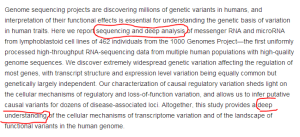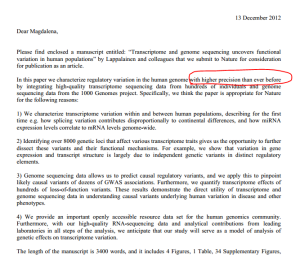
Today's News - BEETL v0.8 Release and RNA Comparison Papers
Tony Cox posted -

It is an implementation of Bauer-Cox-Rosone algorithm mentioned in our blog several times. Heng Li’s ropebwt is another implementation. Readers are encouraged to check the BEETL website.
Release History
Version 0.8.0 (29th October 2013)
New BWT-based tumour-normal filter (see example in doc/BEETL.md)
Beetl-compare modes: ‘split’ renamed to ‘splice’
Beetl-compare modes: new ‘tumour-normal’
16-way parallel beetl-compare
MetaBEETL is now able to run without sequence propagation (which is faster)
Upgraded requirement: autoconf 2.65 (improved regression testing)
Version 0.7.0 (18th September 2013)
New beetl-correct tool
Updated regression tests
Detection of required libraries and OpenMP in configure script
**Version 0.6.0 (27th August 2013)
**
Important: Harmonised file encodings - you may need to rebuild your BWT files or just convert bwt-B00 from BWT_ASCII to BWT_RLE with beetl-convert (bwt-B00 was always ASCII-encoded. It now follows the same encoding as the other piles)
Now requires GCC with C++11 support (gcc 4.3 or above)
New Markdown documentation style
Faster beetl-compare and metaBEETL
Lossless quality compression scripts added, even though they are not using BWT
New features:
BWT creation with reverse-complemented reads (–add-rev-comp)
BWT creation with multiple reads per sequence (–sequence-length)
Support for BCL and BCL.gz in beetl-convert
Here is the last BCR-related paper mentioned in their website -
Adaptive reference-free compression of sequence quality scores
Rapid technological progress in DNA sequencing has stimulated interest in compressing the vast datasets that are now routinely produced. Relatively little attention has been paid to compressing the quality scores that are assigned to each sequence, even though these scores may be harder to compress than the sequences themselves. By aggregating a set of reads into a compressed index, we find that the majority of bases can be predicted from the sequence of bases that are adjacent to them and hence are likely to be less informative for variant calling or other applications. The quality scores for such bases are aggressively compressed, leaving a relatively small number at full resolution. Since our approach relies directly on redundancy present in the reads, it does not need a reference sequence and is therefore applicable to data from metagenomics and de novo experiments as well as to resequencing data.
Results:
We show that a conservative smoothing strategy affecting 75% of the quality scores above Q2 leads to an overall quality score compression of 1 bit per value with a negligible effect on variant calling. A compression of 0.68 bit per quality value is achieved using a more aggressive smoothing strategy, again with a very small effect on variant calling.
-————————————————————————
Those working on RNAseq may find the following papers helpful (h/t: @genetics_blog).
Assessment of transcript reconstruction methods for RNA- seq
We evaluated 25 protocol variants of 14 independent computational methods for exon identification, transcript reconstruction and expression-level quantification from RNA-seq data. Our results show that most algorithms are able to identify discrete transcript components with high success rates but that assembly of complete isoform structures poses a major challenge even when all constituent elements are identified. Expression-level estimates also varied widely across methods, even when based on similar transcript models. Consequently, the complexity of higher eukaryotic genomes imposes severe limitations on transcript recall and splice product discrimination that are likely to remain limiting factors for the analysis of current-generation RNA- seq data.
Optimizing de novo assembly of short-read RNA-seq data for phylogenomics
Computational analysis of bacterial RNA-Seq data
Speaking of comparison between RNAseq methods, @lpachter mentioned:

Why is everyone after FluxCapacitor? Here is why. In a way that advertisers play with words to create marketing slogans (long list here), GTEx played with the word deep (usually used with ‘deep sequencing’) in their abstract. We highlighted two instances below.

Therefore, just like when Google uses ‘don’t be evil’ as marketing slogan, people search for evil acts by Google, the words ‘deep analysis’ and ‘deep understanding’ are being challenged here.
The cover letter for GTEx claims that they characterize variations with ‘higher precision than ever before’. How correct is that? Also, why is ‘higher precision than ever before’ important, but not accuracy?

Also, the word ‘functional’ is elevated from ENCODE’s abstract to their title. Do they really ‘uncover’ ‘functional’ variations? What are their functions?
Transcriptome and genome sequencing uncovers functional variation in humans